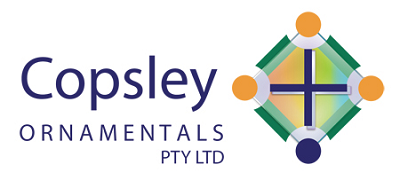FAQ's:
Interesting Facts on Sunflowers and Our Program: Why pollen-free? How long will the flowers last? Are the flowers annual or perennial? Can I keep my own seed? Do sunflowers follow the sun? We seek here to answer such questions plus inform you more about the wonder and beauty of FleuroSun sunflowers.

Development Nursery: All Copsley Ornamentals' sunflower inbreds and pollen-free hybrids are proprietary lines developed in the company's nurseries, located for many years outside Ballarat, and now on the Mornington Peninsula. The program comprises over 70 genetically-fixed inbred lines which are used to make-up some 80 selected pollen-free FleuroSun hybrids. Development of new inbred lines is now largely replaced by small-scale line increases and hybrid make-ups.
Inbred lines comprise maintainer-males, known as B-lines, generally depicted by blue tags on cloth bags, and pollen-free females, known as A-lines, with pink tags on bags. Heads are bagged prior to flowering to prevent insect pollination, to enable pure homozygous lines to be developed, and to make up F1 hybrids - by crossing selected A-lines with B-lines of different genetic background. A hybrid trial is conducted alongside the nursery, to assess advanced hybrids in a realistic commercial situation.
The nursery is a tapestry of plant types and colours, and a visual genetics classroom. The reaction of visitors indicates the potential for sequential plantings of FleuroSun sunflowers to be developed as market outlets and tourist attractions.







POLLEN-FREE TRAIT: In sunflowers, pollen-free flowers are derived using cytoplasmic male sterility, linked to mitochondrial RNA in the maternal (seed) parent; they have normal female stigmas but lack viable anthers.
The pollen-free trait is beneficial for people who suffer from pollen allergies, ensures no pollen smell, avoids pollen-staining and enhances the petal life of flowers - in the garden, in vases after harvest and for enhanced transport and storage of cut-flowers. Flowering heads are still attractive to nectar-collecting bees, which are the majority of bees seen on sunflowers.




MORPHOLOGY OF PETALS & DISC FLORETS: Sunflower heads comprise disc florets in the centre surrounded by ray florets (petals) on the outside. As a member of the Family: Compositae, both the disc florets and ray florets are laid down in reverse spirals, which are very evident when one looks closely at sunflower heads. The outer petals (ray florets) are laid down in two reverse layers, not equally spaced, so the petals have a slightly random look - which adds to their attractive appearance. Similarly, the leaves are not laid down opposite each other along the stem, but in reverse spirals around the stem.
In normal sunflower heads, both the number of florets in a spiral and the number of spirals across the head are members of the Fibonacci series, whose initial numbers are 0, 1, 1, 2, 3, 5, 8, 13, 21, 34, 55, 89, 144, 233 etc. The theoretical number of disc florets in a head is a multiple of two of these numbers, e.g., 34*55 (1870) or 21*89 (1869).
One can partially see spirals in most of Van Gogh's wonderful paintings of sunflowers, indicating he observed the heads and petals fairly closely - more so than in some paintings which depict random dots across sunflower heads or two layers of petals spaced at equal distance around heads.


Are Sunflowers annual or perennial? and can I harvest seed from heads?:
Most ornamental sunflowers, including the Fleurosun range are annuals, requiring seeds to be replanted for the next season. Seed excess to planting will retain its germination and vigour for 1-2 years, if kept in a dry, cool and preferably dark area.
Since all FleuroSun varieties are pollen-free, they won't produce seed unless they receive pollen from an external source. However, any such seed in heads won't be true to type but will segregate between the parental components.
ROTATION WITH THE SUN??: The leaves and buds of sunflowers rotate with the sun; this is termed "nutation" and is implied in the names "sunflower", "tournesol" (French) and "girasol" (Spanish). However, contrary to much opinion, the flowering heads do not rotate; the heads as well as leaves cease rotation at anthesis (appearance of anthers or stigmas) of the first disc floret on the outer ring of the head. This usually occurs at early sunlight in the morning - hence most flowering heads of sunflowers face east or north-east. When crops of oilseed sunflowers are seen along Le Tour de France, for example, many crops have been planted on the western side of the road, for optimal visual effect.
GM OR NON-GM?: The term Genetically-Modified (GM) relates to plants which have had their DNA modified using genetic engineering techniques. All of Copsley Ornamentals inbred lines and FleuroSun hybrids have been developed by traditional plant breeding techniques; none have been Genetically-Modified.





